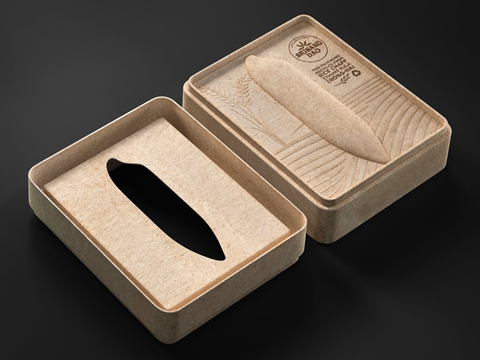
Srisangdao Rice has crafted a die-formed box from the chaff byproduct of its rice production process, with the empty pack intended for reuse as a tissue box.
The company explains that Thailand’s Thung Kula Rong-Hai region is globally recognized for its rice production. Every year it is limited to a controlled environment, which is said to ensure that the rice is high-quality, free of chemicals, and does not negatively impact the environment.
Srisangdao Rice takes the chaff – the outer layer of a rice grain and a natural byproduct of the husking process – and die-forms it into the rice-shaped embossing on top of the box cover. This is then decorated with additional details, including graphic lines and the company logo, which is applied with a burning stamp.
Its textured beige hero colour “speaks to the organic nature of the product”, according to the Dezeen Awards.
Additionally, the lot number and other data is printed directly onto the rice sack, which is placed inside the box.
Once the pack is empty, Srisangdao Rice encourages consumers to reuse it as a tissue box.
The company told Gulfood: “We are one of the leading rice millers equipped with modern and high technology in the milling and packaging process in the northeastern region of Thailand. We collaborate with the rice farmers around our factory by initiating “Srisangdao Direct Seeding Village” project, which aims to enhance farmers’ quality of life through the innovative practice of Direct Seeding.
“Thai Hom Mali Rice is predominantly grown in the northeastern region, especially in Thung Kula Rong-Hai area, which has a distinctive geographical feature that impacts exceptional fragrance and tenderness of the rice.
“We currently have supported Khao Hom Mali Thung Kula Rong-Hai through our “Srisangdao Direct Seeding Village” project and register our Khao Hom Mali Thung Kula Rong-Hai as a Protected Geographical Indication (PGI) product by the European Union.”
In a similar development, TIPA previously converted rice waste into a recyclable, home-compostable tray. The pack is intended as a replacement for plastic and paper takeaway packaging for fruits, vegetables, baked goods, and hot foods, among others.
Other developments for packaging rice include a paper-based pack from Veetee and Mondi, which replaces conventional plastics with recyclable FunctionalPaper; and Tilda’s limited-edition tin designed in collaboration with British Indian artist Natasha Kumar.
If you liked this story, you might also enjoy:
The ultimate guide to the Packaging and Packaging Waste Regulation in 2024
How are the top brands progressing on packaging sustainability?
Sustainable Innovation Report 2024: Current trends and future priorities
Everything you need to know about global plastic sustainability regulation




















No comments yet